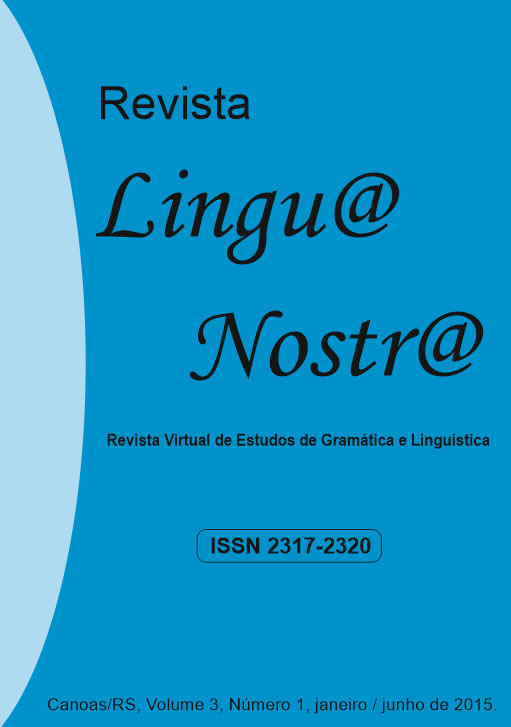Advantages and disadvantages of using skype for educational purposes
DOI:
https://doi.org/10.22481/lnostra.v3i1.13279Palavras-chave:
Innovative methods, Skype applications, English, EducationResumo
Over the last decade, social networks have gained, gradually, considerable space and relevance not only concerning social interactions, but also concerning content transmission and knowledge generation, becoming a niche for propagation and research of various topics. This article aims to investigate the way the potential for interactivity present in Skype mechanisms of enunciation relate to the pedagogical nature of posts aimed at English teaching. For this, we base our reflections on social network studies by Recuero (2009, p.191), on teaching and technology reflections by Paiva (2001) and on virtual ethnography by Hine (2000). The purpose of this article is to provide knowledge about pros and cons connected with the usage of Skype during the process of study foreign languages among Russian people. Research in this sphere is not very developed as internet technologies are new method in education. Our task is to delight all sides of this research. A qualitative exploratory research method was applied to interviews and notes via Skype between students and their web teachers. The data were analysed using phenomenography. The findings are based on the pole in the Internet. The advantages were: being able to be at home; well-known being and convenience for the students; and attend ones possible regardless of geographical distance. Barriers were that the Internet connection works intermittently with audio or picture.
Downloads
Referências
BLANKENSHIP, M. How social media can and should impact higher education. The Education Digest. 76(7), 2011. pp.39-42.
BRANZBURG, J. Talk Is Cheap: Skype Can Make VoIP a Very Real Communication Option for Your School. Technology & Learning, 27(8), 2007. p.36.
COPE, B.; KALANTZIS, M. Multiliteracies: literacy learning and the design of social futures. London: Routledge, 2000.
FOOTE, C. See me, hear me: Chat with authors, record podcasts, and cover reference—all online and for free—with Skype. School Library Journal, 54(1), 2008. pp. 42-43.
GRADDOL, D. English next. <http://www.britishcouncil.org/files/documents/learning-research-english-next.pdf>. (retrieved April 8, 2015)
HAN SHA. LinguaeLive - Connect students who want to learn each other's languages . (retrived April 8, 2015)
HERRING, S. C. Computer-Mediated Communication: Linguistic, Social and Cross-Cultural Perspectives. Pragmatics and Beyond series. - Amsterdam: 1996. pp. 29–46.
HINE, C. Virtual Ethnography. - London: Sage, 2000. <https://books.google.com.br/books>. (retrived April 8, 2015)
LAFFORD, A., LAFFORD, B. A. CMC Technologies for Teaching Foreign Languages: What’s on the Horizon? CALICO Journal. Vol 22(3), 2005. p. 679-709.
LAMY, M-N. Oral Conversations online. Redefining oral competence in synchronous environments. ReCALL, 16(2) 2004. p. 520-538.
LAMY, M-N. & HAMPEL, R. Online communication in language learning and teaching. - New York, Palgrave Macmillan: 2007.
<https://lamymn.wordpress.com/lamy-publications/>. (retrived April 8, 2015)
LEONTIEV; A. N. Os princípios psicológicos da brincadeira pré-escolar. In L. S. Vygotsky, A. R. Luria & A. N. Leontiev. Linguagem, desenvolvimento e aprendizagem (pp. 103-118). São Paulo: Ícone, 1988.
MARKTON, B. "Skype". CNET: 2014. (retrived April 8, 2015)
MARTIN C. Reaching for the Skype: 2015 <http://languagemagazine.com/?page_id=2565>. (retrived April 8, 2015)
MESSNER, K. Met any good authors lately? School Library Journal, 55(8), 2009. pp. 36-38.
_______. An author in every classroom. School Library Journal, 56(9), 2010. pp. 42-44.
PAIVA, J. – As Tecnologias de Informação e Comunicação no Ensino: o caso particular da Antropologia. Faculdade de Ciências e Tecnologia da Universidade de Coimbra, Dissertação de mestrado. 2001.
http://www.portaleducacao.com.br/educacao/artigos/14516/o-ensino-de-ciencias-e-as-tecnologias-de-informacao-e-comunicacao#> (retrived April 8, 2015).
PALLOFF, R. M.; PRATT, K. Building Learning Communities in Cyberspace: Effective strategies for the online classroom. San Francisco, CA: Jossey-Bass. 1999. p.206.
QUILLEN, I. "Educators Move Beyond the Hype Over Skype". Education Week, 2011. http://www.edweek.org/dd/articles/2011/02/09/02skype.h04.html. (retrived April 8, 2015).
RECUERO, R. Redes sociais na internet. – Porto Alegre: Sulina, 2009. (Coleção Cibercultura), p.191. "Skype in the Classroom". Skype in the Classroom. - <https://education.skype.com/> (retrived April 8, 2015)
THOMANN, A. "Skype – A Baltic Success Story". credit-suisse.com, 2006. (retrived April,8 2015) "The Mixxer - a free educational website for language exchanges via Skype". <http://www.language-exchanges.org/content/mixxer-free-educational-website-language-exchanges-skype> (retrived April,8 2015)
WENGER, E. Communities of Practice: learning, meaning and identity. - Cambridge, MA: Cambridge University Press, 1998. <http://www.ewenger.com/theory/index.htm> (retrived April,8 2015).
YATES, S. J. Oral and written linguistic aspects of computer conferencing. 1996, pp.29-46 < http://bulba.sdsu.edu/~malouf/ling795/Yates.pdf> (retived April,8 2015).
Publicado
Como Citar
Edição
Seção
Licença
Copyright (c) 2023 Língu@ Nostr@

Este trabalho está licenciado sob uma licença Creative Commons Attribution 4.0 International License.






